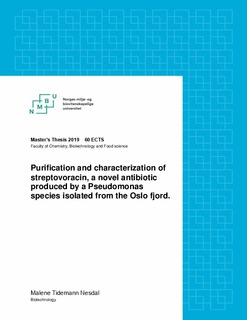| dc.contributor.advisor | Håvarstein, Leiv Sigve | |
| dc.contributor.advisor | Straume, Daniel | |
| dc.contributor.author | Nesdal, Malene Tidemann | |
| dc.date.accessioned | 2019-07-24T07:24:01Z | |
| dc.date.available | 2019-07-24T07:24:01Z | |
| dc.date.issued | 2019 | |
| dc.identifier.uri | http://hdl.handle.net/11250/2606347 | |
| dc.description.abstract | Antibiotikaresistent Streptococcus pneumoniae er en av de 18 største bakterielle truslene verden står ovenfor. Bakterien er alene ansvarlig for oppunder 2 millioner dødsfall hvert år på verdensbasis. På grunn av stadig økende antibiotikaresistens hos S. pneumoniae og andre viktige patogener er det nødvendig å oppdage nye antibiotika for å ligge i forkant av resistensutviklingen. Forskningsgruppen Molekylær Mikrobiologi ved NMBU isolerte derfor bakterier fra Oslofjorden i håp om å finne nye antibiotika som er aktive mot S. pneumoniae. De fant en bakterie (Pseudomonas isolat nr. 33) som hemmet vekst av S. pneumoniae ved å produsere det som så ut til å være et nytt antibiotikum. Antibiotikumet fikk navnet streptovoracin og ble identifisert som et «cyclic lipopeptide» (CLP).
I de innledende studiene av streptovoracin så det ut til at antibiotikumet er svært smalspektret og kun aktivt mot enkelte medlemmer av slekten Streptococcus. Ett av hovedmålene med denne oppgaven var å undersøke sensitiviteten til et vesentlig større antall bakterier for å kartlegge aktivitetsspekteret til streptovoracin. Resultatene viste at de fleste streptokokker hemmes av streptovoracin. Et klart unntak er Streptococcus mutans, bakterien som forårsaker tannråte. Utenom slekten Streptococcus, var det bare Enterococcus faecalis som viste seg å være sensitiv blant de Gram-positive bakteriene som ble testet. De Gram-negative bakteriene blir trolig ikke hemmet av streptovoracin, men siden jeg kun testet Escherichia coli bør flere arter undersøkes før en kan si dette med sikkerhet. På bakgrunn av disse resultatene var det svært overraskende at to arter innen fylum Actinobacteria ble hemmet av streptovoracin, nemlig en art innen slekten Dietzia og Mycobacterium smegmatis. Sistnevnte er i nært slekt med Mycobacterium tuberculosis, noe som tyder på at streptovoracin er aktivt også mot dette viktige humanpatogenet. Siden S. pneumoniae og M. smegmatis står veldig langt fra hverandre fylogentisk, er det mulig at de hemmes ved ulike mekanismer. | nb_NO |
| dc.description.abstract | Antibiotic resistant Streptococcus pneumoniae is among the 18 most life-threatening human pathogens in the world. This bacterium alone is responsible for almost 2 million deaths every year worldwide. Due to the ever-increasing antibiotic resistance observed for S. pneumoniae and other important pathogens, it is crucial to discover new antibiotics in order to be one step ahead of the resistance development. For this reason, the Molecular Microbiology group at NMBU isolated bacteria from the Oslo fjord with the aim to find new antibiotics that are active against S. pneumoniae. A Pseudomonas strain termed isolate no. 33 was identified and shown to produce a substance that inhibited the growth of pneumococci. The potentially novel antibiotic was named streptovoracin and was identified as a cyclic lipopeptide.
In the initial studies performed on streptovoracin, it looked like the antibiotic is very narrow-spectered and that it is only active against members of the genus Streptococcus. One of the main goals of my thesis was to perform a more comprehensive screening of target bacteria to map the inhibition spectrum of streptovoracin. The results showed that the growth of most streptococci are inhibited by streptovoracin. A notable exception is Streptococcus mutans, the bacterium causing tooth decay. Apart from the genus Streptococcus, only Enterococcus faecalis turned out to be sensitive among the Gram-positive bacteria tested. Gram-negative bacteria are probably insensitive to streptovoracin, but since I only tested Escherichia coli additional species must be examined before reliable conclusions can be drawn. On the basis of these findings, it came as a big surprise that two species belonging to the phylum Actinobacteria were sensitive to streptovoracin, namely a member of the genus Dietzia and Mycobacterium smegmatis. The latter is closely related to Mycobacterium tuberculosis, indicating that streptovoracin is active against this important human pathogen as well. Since S. pneumoniae and M. smegmatis belongs to different phyla and consequently are distantly related, their growth is probably inhibited by different mechanisms. | nb_NO |
| dc.language.iso | eng | nb_NO |
| dc.publisher | Norwegian University of Life Sciences, Ås | nb_NO |
| dc.rights | Attribution-NonCommercial-NoDerivatives 4.0 Internasjonal | * |
| dc.rights | Attribution-NonCommercial-NoDerivatives 4.0 Internasjonal | * |
| dc.rights.uri | http://creativecommons.org/licenses/by-nc-nd/4.0/deed.no | * |
| dc.subject | Cyclic lipopeptide | nb_NO |
| dc.subject | Streptococcus pneumoniae | nb_NO |
| dc.subject | Pseudomonas fluorescens | nb_NO |
| dc.title | Purification and characterization of streptovoracin, a novel antibiotic produced by a Pseudomonas species isolated from the Oslo fjord | nb_NO |
| dc.title.alternative | Rensing og karakterisering av streptovoracin, et nytt antiotikum produsert av en Pseudomonas-art isolert fra Oslofjorden | nb_NO |
| dc.type | Master thesis | nb_NO |
| dc.source.pagenumber | 121 | nb_NO |
| dc.description.localcode | M-BIOTEK | nb_NO |

